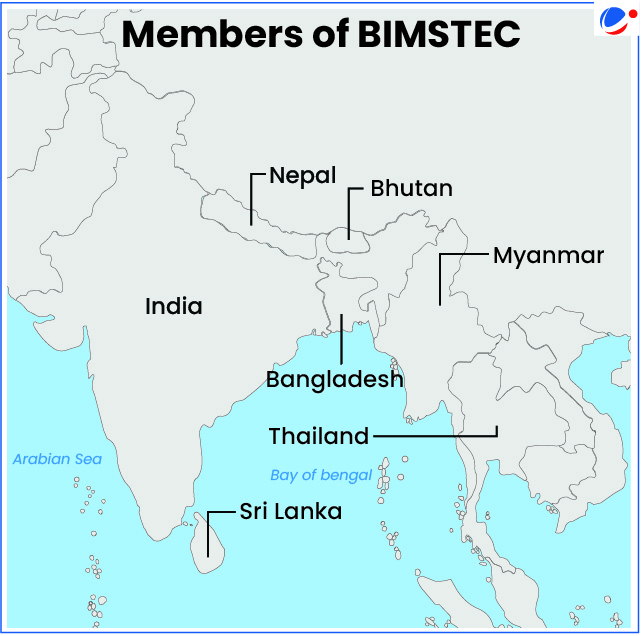Why in the News?
The 6th BIMSTEC (Bay of Bengal Initiative for Multi-Sectoral Technical and Economic Cooperation) Summit with the theme "BIMSTEC: Prosperous, Resilient and Open", concluded in Bangkok under the chairmanship of Thailand.
Major India -Led Initiatives launched at 6th BIMSTEC Summit
- BIMSTEC Centres of Excellence: To be set up in India on Disaster Management, Sustainable Maritime Transport, Traditional Medicine, and Research and Training in Agriculture.
- BODHI (BIMSTEC for Organized Development of Human Resource Infrastructure): For skilling the youth through training & scholarships to professionals, students, researchers, etc.
- Digital Public Infrastructure: India to conduct a pilot study assessing its need in the region.
- Strengthening people-to-people linkages: India to host first BIMSTEC Games in 2027. India would also host BIMSTEC Traditional Music Festival.
Other Outcomes
|
About BIMSTEC

- Genesis: It is a regional organization established in 1997 with signing of the Bangkok Declaration.
- It was originally formed with 4 Members (Bangladesh, India, Sri Lanka & Thailand) with the acronym 'BIST-EC'.
- Secretariat: Dhaka, Bangladesh
- Member States (7): Bangladesh, Bhutan, India, Myanmar, Nepal, Sri Lanka, and Thailand.
- BIMSTEC Charter: Foundational document that outlines the goals, principles, and structure of the BIMSTEC. It was finalized in the 5th Summit (2022) in Sri Lanka.
- Charter confers legal personality on the grouping and paves the way for external partnerships and admission of observers and new members.
- Objective: To create an enabling environment for rapid economic development and social progress and maintain peace and stability in the Bay of Bengal region.
- 7 Priority Areas/Pillars (each led by 1 Member country): Trade & Investment (Bangladesh); Environment & Climate Change (Bhutan); People-to-People Contacts (Nepal); Agriculture & Food Security (Myanmar); Science &Technology and Innovation (Sri Lanka) and Connectivity (Thailand).
- India is the Lead Country for Security pillar under which there are 3 sub-sectors – Counter-Terrorism and Transnational Crime, Disaster Management and Energy Security.
How BIMSTEC can help realize India's foreign policy objectives?
- Alternative to SAARC: SAARC's progress has been hampered by India-Pakistan tensions. BIMSTEC excludes Pakistan, offering India a more functional platform for regional cooperation.
- SAARC (South Asian Association for Regional Cooperation) remains largelydefunct due to geopolitical tensions, especially India-Pakistan rivalry.
- Aligned with India's Foreign Policy: BIMSTEC aligns closely with India's 'Act East' and 'Neighbourhood First' policies.
- It could also be seen as aligning with India's broader goal of enhancing trade and security in the IOR and supporting the Indo-Pacific vision championed by QUAD countries.
- Strategic bridge between South Asia and Southeast Asia: Effectively linking India with ASEAN countries through member states like Thailand and Myanmar, which are part of ASEAN.
- A stronger partnership between ASEAN and BIMSTEC could create a broader Indo-Pacific framework that connects continental and maritime Asia.
- Blue Economy and Maritime security: Promotes India's interests in Bay of Bengal and helps in securing maritime trade routes, anti-piracy operations, and disaster management.
- This also effectively aligns with India's SAGAR (Security and Growth for All in the Region) and MAHASAGAR (Mutual and Holistic Advancement for Security and Growth Across Regions) in Indian Ocean Region.
- South Asian integration: Focuses on infrastructure, energy, and transport connectivity, promoting regional integration through projects like the BIMSTEC Master Plan for Transport Connectivity
Issues with BIMSTEC
- Slow Organizational Progress: The charter enforced after 27 years of formation. Just 6 summits, including the current one, have been held in the last 27 years.
- BIMSTEC didn't have an official headquarters or secretariat until 2011. However it presently suffers from inadequate financial & manpower assistance for its operational activities.
- Geopolitical Challenges: China's growing influence in member countries through the Belt and Road Initiative (BRI) creates strategic concerns for India.
- All BIMSTEC member countries except India and Bhutan are part of BRI projects, giving China strategic leverage across South and Southeast Asia.
- Low Intra-Regional Trade: Despite its potential, intra-BIMSTEC trade remains relatively low i.e., around 6-7% of total trade, indicating a lack of deep economic integration.
- The BIMSTEC FTA, initiated in 2004, remains unimplemented despite numerous negotiations, hindering trade liberalization and economic integration within the region.
- Infrastructural and Connectivity Gaps: Poor physical connectivity among member states due to stalled connectivity projects or delays in execution limits trade, people-to-people contact, and integration.
- E.g., India-Myanmar-Thailand (IMT) Trilateral Highway, Bangladesh-Bhutan-India-Nepal (BBIN) Motor Vehicles Agreement, etc., are facing considerable delays.
- Political Instability: Internal political crises and conflicts in member states like Myanmar, Nepal, and Sri Lanka divert attention and resources, hindering regional cooperation.
- Strained Relations between Members e.g. Bangladesh-Myanmar relations over the Rohingya refugee crisis, the India-Nepal border issue, etc. also hinders cooperation.
Conclusion
BIMSTEC represents a functional, forward-looking grouping that aligns well with India's geopolitical and economic interests, especially in light of SAARC's stagnation. It exemplifies India's strategic pivot towards subregional and transregional cooperation to bypass the limitations of older frameworks and enhance regional integration under India's leadership.






